 W
WAn aircraft carrier is a warship that serves as a seagoing airbase, equipped with a full-length flight deck and facilities for carrying, arming, deploying, and recovering aircraft. Typically, it is the capital ship of a fleet, as it allows a naval force to project air power worldwide without depending on local bases for staging aircraft operations. Carriers have evolved since their inception in the early twentieth century from wooden vessels used to deploy balloons to nuclear-powered warships that carry numerous fighters, strike aircraft, helicopters, and other types of aircraft. While heavier aircraft such as fixed-wing gunships and bombers have been launched from aircraft carriers, it is currently not possible to land them. By its diplomatic and tactical power, its mobility, its autonomy and the variety of its means, the aircraft carrier is often the centerpiece of modern combat fleets. Tactically or even strategically, it replaced the battleship in the role of flagship of a fleet. One of its great advantages is that, by sailing in international waters, it does not interfere with any territorial sovereignty and thus obviates the need for overflight authorizations from third-party countries, reduces the times and transit distances of aircraft and therefore significantly increase the time of availability on the combat zone.
 W
WThis list of aircraft carriers contains aircraft carriers listed alphabetically by name. An aircraft carrier is a warship with a full-length flight deck and facilities for carrying, arming, deploying, and recovering aircraft, that serves as a seagoing airbase.
 W
WAn aircraft catapult is a external device used to allow aircraft to takeoff from a very limited amount of space, such as the deck of a vessel, but also installed land-based runways in rare cases. It is now most commonly used on aircraft carriers, as a form of assisted take off. In the form used on aircraft carriers the catapult consists of a track, or slot, built into the flight deck, below which is a large piston or shuttle that is attached through the track to the nose gear of the aircraft, or in some cases a wire rope, called a catapult bridle, is attached to the aircraft and the catapult shuttle. Other forms have been used historically, such as mounting a launching cart holding a seaplane on a long girder-built structure mounted on the deck of a warship or merchant vessel, but most catapults share a similar sliding track concept. Different means have been used to propel the catapult, such as weight and derrick, gunpowder, flywheel, air pressure, hydraulic, and steam power, and solid fuel rocket boosters. The U.S. Navy is developing the use of Electromagnetic Aircraft Launch Systems with the construction of the Gerald R. Ford-class aircraft carriers. On a modern carrier catapulted aircraft land like conventional aircraft, sometimes with the help of arresting gear when landing on deck. Historically it was most common for seaplanes to be catapulted, allowing them to land on the water near the vessel and be hoisted onboard, although in WWII conventional fighter planes would sometimes be catapulted from "catapult-equipped merchant" (CAM) vessels to drive off enemy aircraft, forcing the pilot to either divert to a land based airstrip, or to jump out by parachute or ditch in the water near the convoy and wait for rescue. Some fighters were even completed without landing gear for this purpose, intended to be emergency single-use disposable fighters to drive off enemy aircraft if they attacked or spotted the convoy.
 W
WAircraft carriers have their origins during the days of World War I. The earliest experiments consisted of fitting temporary "flying off" platforms to the gun turrets of the warships of several nations, notably the United States and the United Kingdom. The first ship to be modified with a permanent flight deck was the battlecruiser HMS Furious, which initially had a single flying-off deck forward of the original superstructure. Subsequently, she was modified with a separate "landing on" deck aft and later with a full flush deck. Other ships, often liners, were modified to have full flush flight decks, HMS Argus being the first to have such modification begun. Those first faltering steps gave little indication of just how important the aircraft carrier was to prove to be. During the inter-war years, Japan, the United Kingdom and the United States built up significant carrier fleets so that by the beginning of World War II, they had 18 carriers between them. The 1940 Battle of Taranto and 1941 Attack on Pearl Harbor in retrospect showed the world that the aircraft carrier was to be the most important ship in the modern fleet. Today, aircraft carriers are the capital ships of the navies they serve in, and in the case of modern US "supercarriers", they embark an air group that is effectively a small air force.
 W
WThe Advanced Arresting Gear (AAG) is a type of arresting gear currently in development by General Atomics for the U.S. Navy's newest Gerald R. Ford-class aircraft carriers.
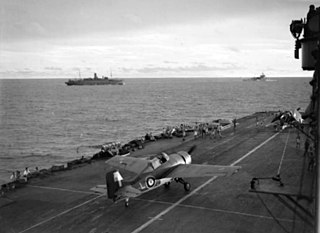 W
WAircraft carriers are warships that evolved from balloon-carrying wooden vessels into nuclear-powered vessels carrying scores of fixed- and rotary-wing aircraft. Since their introduction they have allowed naval forces to project air power great distances without having to depend on local bases for staging aircraft operations.
 W
WAn anti-submarine warfare carrier is a type of small aircraft carrier whose primary role is as the nucleus of an anti-submarine warfare hunter-killer group. This type of ship came into existence during the Cold War as a development of the escort carriers used in the ASW role in the North Atlantic during World War II.
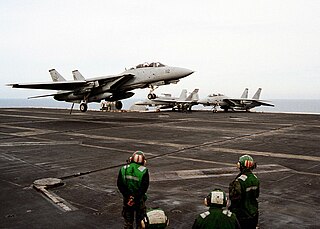 W
WAn arresting gear, or arrestor gear, is a mechanical system used to rapidly decelerate an aircraft as it lands. Arresting gear on aircraft carriers is an essential component of naval aviation, and it is most commonly used on CATOBAR and STOBAR aircraft carriers. Similar systems are also found at land-based airfields for expeditionary or emergency use. Typical systems consist of several steel wire ropes laid across the aircraft landing area, designed to be caught by an aircraft's tailhook. During a normal arrestment, the tailhook engages the wire and the aircraft's kinetic energy is transferred to hydraulic damping systems attached below the carrier deck. There are other related systems which use nets to catch aircraft wings or landing gear. These barricade and barrier systems are only used for emergency arrestments for aircraft without operable tailhooks.
 W
WA carrier battle group (CVBG) is a naval fleet consisting of an aircraft carrier capital ship and its large number of escorts, together defining the group.
 W
WA carrier strike group (CSG) is a type of carrier battle group of the United States Navy. It is an operational formation composed of roughly 7,500 personnel, usually an aircraft carrier, at least one cruiser, a destroyer squadron of at least two destroyers or frigates, and a carrier air wing of 65 to 70 aircraft. A carrier strike group also, on occasion, includes submarines, attached logistics ships and a supply ship. The carrier strike group commander operationally reports to the commander of the numbered fleet, who is operationally responsible for the area of waters in which the carrier strike group is operating.
 W
WCATOBAR is a system used for the launch and recovery of aircraft from the deck of an aircraft carrier. Under this technique, aircraft launch using a catapult-assisted take-off and land on the ship using arrestor wires.
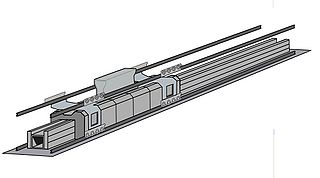 W
WThe Electromagnetic Aircraft Launch System (EMALS) is a type of aircraft launching system developed by General Atomics for the United States Navy. The system launches carrier-based aircraft by means of a catapult employing a linear induction motor rather than the conventional steam piston. EMALS was first installed on the United States Navy's Gerald R. Ford-class aircraft carrier, USS Gerald R. Ford.
 W
WA fleet carrier is an aircraft carrier designed to operate with the main fleet of a nation's navy. The term was developed during World War II, to distinguish it from the escort carrier and other less capable types. In addition to many medium-sized carriers, supercarriers, as well as some light carriers, are also classed as fleet carriers.
 W
WThe flight deck of an aircraft carrier is the surface from which its aircraft take off and land, essentially a miniature airfield at sea. On smaller naval ships which do not have aviation as a primary mission, the landing area for helicopters and other VTOL aircraft is also referred to as the flight deck. The official U.S. Navy term for these vessels is "air-capable ships".
 W
WA helicopter carrier is a type of aircraft carrier whose primary purpose is to operate helicopters. A helicopter carrier has a large flight deck that occupies a large part of the ship, which can extend the full length of the ship like HMS Ocean of the Royal Navy (RN), or only partway, usually aft, as in the Soviet Navy's Moskva class, the Chinese Navy's Type 0891A or the Royal Fleet Auxiliary's (RFA) RFA Argus. It often also has a hangar deck for the storage of aircraft.
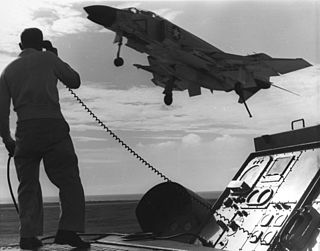 W
WA landing signal officer or landing safety officer (LSO), also informally known as paddles or batsman, is a naval aviator specially trained to facilitate the "safe and expeditious recovery" of naval aircraft aboard aircraft carriers. Originally LSOs were responsible for bringing aircraft aboard ship using hand-operated signals. Since the introduction of optical landing systems in the 1950s, LSOs assist pilots by giving information via radio handsets.
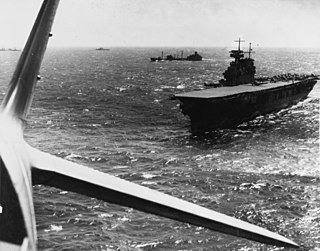 W
WAircraft carrier air operations include a launch and recovery cycle of embarked aircraft. Launch and recovery cycles are scheduled to support efficient use of naval aircraft for searching, defensive patrols, and offensive airstrikes. The relative importance of these three missions varies with time and location. Through the first quarter-century of aircraft carrier operations, launch and recovery cycles attempted to optimize mission performance for ships with a straight flight deck above an aircraft storage hangar deck. Carrier air operations evolved rapidly from experimental ships of the early 1920s through the combat experience of World War II.
 W
WA merchant aircraft carrier was a limited-purpose aircraft carrier operated under British and Dutch civilian registry during World War II. MACs were adapted by adding a flight deck to a bulk grain ship or oil tanker enabling it to operate anti-submarine aircraft in support of Allied convoys during the Battle of the Atlantic.
 W
WAn optical landing system (OLS) is used to give glidepath information to pilots in the terminal phase of landing on an aircraft carrier.
 W
WA ramp strike or rampstrike is when an aircraft coming to land aboard an aircraft carrier impacts the rear of the carrier, also called the ramp, below the level of the flight deck.
 W
WA seaplane tender is a boat or ship that supports the operation of seaplanes. Some of these vessels, the seaplane carriers, could not only carry seaplanes but also provided all the facilities needed for their operation; these ships are regarded by some as the first aircraft carriers and appeared just before the First World War.
 W
WIn aviation, a ski-jump is an upward-curved ramp that allows aircraft to take off from a runway that is shorter than the aircraft's required takeoff roll. By forcing the aircraft upwards, lift-off can be achieved at a lower airspeed than that required for sustained flight, while allowing the aircraft to accelerate to such speed in the air rather than on the runway. Ski-jumps are commonly used to launch airplanes from aircraft carriers that lack catapults.
 W
WSTOBAR is a system used for the launch and recovery of aircraft from the deck of an aircraft carrier, combining elements of "short take-off and vertical landing" (STOVL) with "catapult-assisted take-off but arrested recovery" (CATOBAR).
 W
WA submarine aircraft carrier is a submarine equipped with aircraft for observation or attack missions. These submarines saw their most extensive use during World War II, although their operational significance remained rather small. The most famous of them were the Japanese I-400-class submarines and the French submarine Surcouf, although small numbers of similar craft were built for other nations' navies as well.
 W
WNaval tactics play a crucial role in modern battles and wars. The presence of land, changing water depths, weather, detection and electronic warfare, the speed at which actual combat occurs and other factors — especially air power — have rendered naval tactics essential to the success of any naval force.